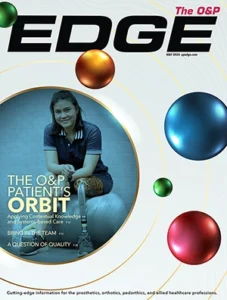Once again I would like to thank the list and all who responded to my
query. Here is a compilation of the responses.
I am a LBK, I know you have a AK patient, but may be my info will help
you. I skate about 10 to 30 miles average a week, more in the summer
less in the=20
winter.
I use a Genesis II foot frame with the stiffest bumpers.
You do not want any inversion or eversion, very little planter or dorsi=20
flex at the foot. This foot is very light. I have it attached to a
metal=20
plate and use a roller hockey type of blade under the plate.
=20
=20
I have met in my skating adventures 1 AK that skates. He used a
modified=20
knee as I recall that had an extra return spring to bring the knee to
the=20
forward yet semi bent position. (Don’t want to be straight knee). He
said=20
the balance was the biggest issue, he was very strong in the meat leg
and=20
upper body. We discussed the possibility of a “scooter” for the AK side
that would have socket attached to the frame but the base would provide=20
stability while on the AK side, this arrangement still would not provide
for a “push off”, but would allow for a easier activity. It would need=20
steering. There is a 4 wheel device out there now, to kneel on for BK’s
and persons with bad feet. It could be made to have steering wheels and
mount a socket with a pyramid coupler on it.
=20
=20
As an FYI, I downhill snow ski and Teach adaptive skiing here in
Washington=20
state. I use a foot that snaps straight to the ski binding without a=20
boot. again weight is important.
I wonder if the C-leg could be programmed to work for skating…
I teach downhill skiing. Don’t see any AK’s
=20
I have experience with several TF clients who have rollerbladed
with essentially the same setup you describe. The rollerblade “boot”
controls the knee flexion, allowing just the right amount, before the
weight shifts to the other limb. Keep the stance adjustment all the way
up.
I would be interested to see how the C-leg would handle
rollerblading. I suspect it would offer greater stability at deeper knee
flexion angles.=20
Best of luck to you and your client.
=20
=20
=20
=20
=20
=20
I’ve taught two transfemorals to rollerblade and it was none too easy.=20
Both were using suction sockets, Mauch SNS knees, and dynamic feet. The
main issue is one of safety – once the prosthetic limb is out in front
of the sound limb, it is totally unstable. Early learning and staying
upright is accomplished by keeping the prosthetic limb under the body at
the start of the glide with a short push accomplished with the
prosthetic limb behind the body. I started with a lot of focus on
gliding, weaving patterns, and single limb balance during gliding.=20
Suggest your patient consider using brakes on both sides rather than
just one. The altered mechanics on the prosthetic side, maintaining
extension versus striking forth in flexion, made for some low back pain.
=20
=20
A socket design for snowboarding to limit knee flexion I think would
work great for rollerblading. The prosthesis I saw had a large bump
extension of laminated material proximal to the knee on the distal
anterior socket. Over top of this goes a thick 4″ layer of webbing
doubled over on itself. The webbing attaches to the socket above this
‘bump’, crosses over the knee joint, and inserts into the shin section
below the frame. The multiple layers of webbing provide a flexion stop
limiting the range of knee flexion. This webbing was removable, however
the ‘bump’ of laminated material obviously part of the socket.=20
Hope that helps.
=20
=20
Rick, as an above knee amputee myself I can say that the componentry you
have on this gentleman is fine; the real problem is the knee collapsing.
Just like the boxer that was discussed awhile back some type of flexion
inhibitor like a strap tends to work best to stop the knee from
buckling.
=20
The only rollerskating transfemoral amputee that I’ve ever known was a
WW II veteran. He used a suction socket; single axis, constant friction
knee and a single axis foot. Not what one would call a very
sophisticated prosthesis by today’s standards. =20
My personal feelings are that your patient should try to skate with the
prosthesis that he currently has to determine if he can. Then, he will
be better able to tell you what he feels that he is lacking.
I once fabricated a prosthesis for just such a patient. We found using
an Endolite foot ankle system, with the TT pylon worked well.. The
Snubber and Ball stem was set one step lighter than what patient would
normally have. The knee we used was Ossur Total Knee.
=20
I’d think about axial rotation, but check the skate to see if a=20
Multi-axis foot would be of any use. I think that there is no motion in=20
The ankle or toe so a SACH for skating would be a cheap alternative. =20
Skaters spend a lot time in a bent knee position the need for stability=20
in extension is minimal, stability in flexion is needed so something=20
that arrests flexion in a specific ROM is needed. I can’t think of a=20
knee that would do the trick.
=20
I have had a few AK amputees skate again. I believe that they really
don’t need specific components because most of the force to propel them
forward is hip extensors and abductors. Lack of knee motion and strength
will slow the patient down and limit control, but I don’t know if one
specific knee would help more than another. The patients I have had have
used in-line skates and there is no ankle motion anyway on the
non-amputee. You will probably have a difficult time with in-line skate
with the pathfinder foot.
=20
>From my experiences skating, I think your pt would do pretty well with a
lighter foot, and a 4R39 rotator. Depending on finances, you could get
by with a SAFE foot, and a multi-axis ankle, Greissenger, or (if money
isn’t an issue), you could use a more expensive alternative.
=20
Right now, Freedom Innovations is offering a 50 refund on its feet for
participating in a clinical survey if you are interested. I think the
FS-1000 would work well for this, and would let you get by without using
the separate ankle.
=20
I have a transfemoral amputee who is interested in getting back into=20
>rollerskating. He currently is wearing a suction socket, Mauch SNS with
>Mark V knee frame attached to a Pathfinder. What combination of=20
>hardware works the best? Does one need axial rotation, multi-axis foot?
>Does any amputee out there have experience with different setups and=20
>which setups give the best response. My amputee used to skate a lot=20
>prior to his accident and wants to get back into with his wife and=20
>little girl.
=20
Sincerely,
Rick Stapleton, CP
=20
=20
=20




